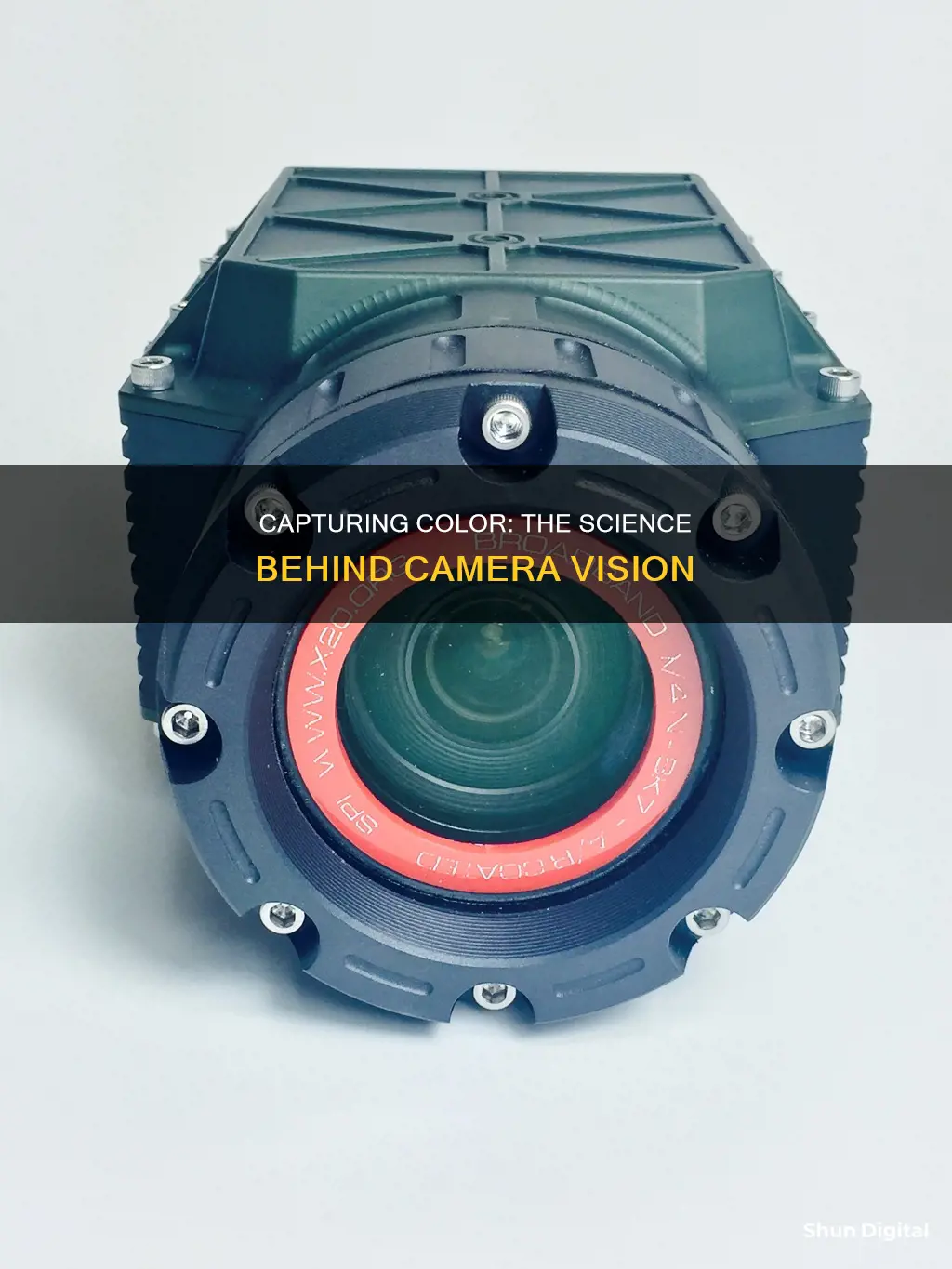
Cameras do not see colour in the same way that humans do. In order to capture a full-colour image, cameras must use a mechanism to separate the red, green and blue colour components of light. They do this by using filters to look at the light in its three primary colours and then combining them to create the full spectrum. This process is called demosaicing.
| Characteristics | Values |
|---|---|
| How cameras see color | Cameras use filters to separate the three primary colors (red, green, and blue) and then combine them to create the full spectrum. |
| They use mechanisms such as filter array masks, moving filters, multiple sensors, or fast-switching light sources to capture color images. | |
| Color perception | Color is an interpretation that occurs in our brain. Different creatures perceive color differently. |
| Bayer array | A common type of color filter array used in cameras, consisting of alternating rows of red-green and green-blue filters. |
| Demosaicing | The process of translating a Bayer array of primary colors into a full-color image, using overlapping arrays to extract more image information. |
| Moiré | A common artifact in digital images, appearing as repeating patterns, color artifacts, or pixels arranged in an unrealistic maze-like pattern. |
What You'll Learn

Cameras use filters to see red, green, and blue light
Digital cameras use an array of millions of tiny light cavities or "photosites" to record an image. These photosites are covered by filters that allow only particular colours of light to pass through. The most common type of colour filter array is the Bayer array, which consists of alternating rows of red-green and green-blue filters. Each photosite can only record the light that is able to pass through the colour filter located directly in front of it.
To create a full-colour image, cameras use a process called "demosaicing" or "de-Bayering", where the colour information from neighbouring pixels is combined to assign an RGB (red, green, blue) value to each photosite. This results in a full-colour image where each pixel has an RGB intensity value, which can be combined to create a wide range of colours.
The Bayer array contains twice as many green filters as red or blue because the human eye is more sensitive to green light. This redundancy in green pixels produces an image with finer details and less noise.
Other methods of capturing colour images include using multiple sensors or cameras, each dedicated to a specific colour, or using a fast-switching light source that quickly alternates between red, green, and blue excitation light.
The Camera's Eye: Who's Watching?
You may want to see also

Cameras combine these colours to create the full spectrum
Cameras use a combination of techniques to capture and reproduce colour. The human eye sees colour as a combination of three primary colours – red, green and blue. This is known as the RGB model. Similarly, cameras use this model to capture and reproduce colour.
Cameras use sensors to capture light. However, these sensors cannot differentiate between colours. To capture colour images, cameras use a mechanism to separate the red, green and blue colour components of light. This is done by using filters. Each sensor gets an identical look at the image, but because of the filters, each sensor only responds to one of the primary colours.
Once the camera records all three colours, it combines them to create the full spectrum. This is known as demosaicing. There are several ways to record the three colours in a digital camera. One way is to use three separate sensors, each with a different filter. Another method is to rotate a series of red, blue and green filters in front of a single sensor. This method records three separate images in rapid succession.
The Bayer array is the most common type of colour filter array. It consists of alternating rows of red-green and green-blue filters. The Bayer array contains twice as many green as red or blue sensors, as the human eye is more sensitive to green light. This produces an image that appears less noisy and has finer details.
After capturing the light, the camera processes the information to create a colour image. This involves comparing the relative brightness of neighbouring pixels that are filtered with different colours. This information is then used to create an RGB value for each pixel, resulting in a full-colour image.
Switching Cameras: A Guide to Multi-Cam Techniques for Videos
You may want to see also

Cameras use photosites to record an image
Each photosite has a single photodiode that records a luminance value. When light photons enter the lens, they pass through the lens aperture, and a portion of light is allowed through to the camera sensor when the shutter is activated at the start of the exposure. Once the photons hit the sensor surface, they pass through a micro-lens attached to the receiving surface of each of the photosites, which helps direct the photons into the photosite. Then, the photons pass through a colour filter, such as the Bayer filter, which is used to help determine the colour of the pixel in an image.
Each photosite holds a specific number of photons, sometimes called the well depth. When the exposure is complete, the shutter closes, and the photodiode gathers the photons, converting them into an electrical charge, i.e. electrons. The strength of the electrical signal is based on the number of photons captured by the photosite. This signal then passes through the ISO amplifier, which makes adjustments to the signal based on the ISO settings of the camera.
The photosites are colourblind and only keep track of the total intensity of the light that strikes their surface. To get a full-colour image, most sensors use filtering to look at the light in its three primary colours: red, green, and blue. Once the camera records all three colours, it combines them to create the full spectrum.
Can Roku TVs Spy on You?
You may want to see also

Bayer array is the most common type of colour filter array
Cameras use a mechanism to separate the red, green, and blue color components of light to capture color images. The Bayer array, or Bayer filter, is the most common type of color filter array (CFA) used in digital cameras. It was invented in 1974 by Bryce Bayer of Eastman Kodak and is used in most single-chip digital image sensors. The Bayer array consists of a 2x2 pattern of pixel filters, with twice as many green filters as red or blue ones. This arrangement, also known as GRBG, RGBG, or RGGB, mimics the physiology of the human eye, which is more sensitive to green light.
Each pixel in the Bayer array corresponds to a specific color and is dedicated to imaging only that color. The filter prevents the passage of light that is not of the desired color, allowing a pixel to capture the intensity of its designated color. For example, a pixel with a green filter will provide an exact measurement of the green component, while the red and blue components will be obtained from neighboring pixels. This process is known as demosaicing or de-Bayering, and it involves using various algorithms to interpolate a complete set of red, green, and blue values for each pixel.
The Bayer array offers several advantages. Firstly, it provides a good compromise between horizontal and vertical resolutions and luminance and chrominance sensitivities, making it suitable for industrial applications. Secondly, it is simple and cost-effective, requiring only a single sensor without any moving parts. This makes it a popular choice for small, efficient cameras. However, one of the main drawbacks of the Bayer array is the loss of resolution and sensitivity due to the interpolation and binning of neighboring pixels.
Smart TVs: Are They Watching You?
You may want to see also

Cameras use interpolation to create a higher resolution image
Cameras use interpolation to create a higher-resolution image. This process involves enlarging a digital photo by increasing the size of pixels within an image. This is done through software programs that use complex mathematical calculations to add extra pixels, enhancing the image resolution beyond its original size.
Interpolation is particularly useful in digital zoom, allowing you to focus on subjects beyond the maximum range of your camera's lens. It is also employed in post-production editing software, such as Adobe Photoshop, to manipulate images.
There are four common types of interpolation: nearest-neighbor, bilinear, bicubic, and fractal. Nearest-neighbor interpolation is the simplest method, enlarging pixels without considering their neighbouring pixels, resulting in jagged edges or pixelation. Bilinear interpolation improves on this by taking into account the original pixel and four adjacent pixels, producing smoother results but still reducing overall image quality. Bicubic interpolation is the most advanced of these four methods, utilising information from the original pixel and 16 surrounding pixels to create a new pixel, resulting in sharper images suitable for printing. Fractal interpolation, used for large prints, samples from even more pixels, producing sharper edges and less blurring but requiring specialised software.
While interpolation can enhance image resolution, it is important to note that it also introduces information that can degrade image quality. Issues such as blurriness, artifacts, and pixelation can occur, especially if the image is enlarged too much.
The Japanese Movie 'Don't Stop Camera' is a Must-Watch
You may want to see also
Frequently asked questions
Cameras use an array of tiny light cavities or "photosites" to record an image. To capture colour images, a filter has to be placed over each cavity that permits only particular colours of light to pass through.
Cameras need to filter light into separate red, green, and blue values to mimic the trichromatic nature of the human eye.
Cameras use three primary colours to capture a full-colour image. Once the camera records all three colours, it combines them to create the full spectrum.
A Bayer array is a type of colour filter array (CFA) that consists of alternating rows of red-green and green-blue filters. It is the most common type of CFA used in digital cameras.
Demosaicing is the process of translating the Bayer array of primary colours into a final image that contains full-colour information at each pixel. This is done by using mathematical algorithms to interpolate the colour information from neighbouring pixels.







